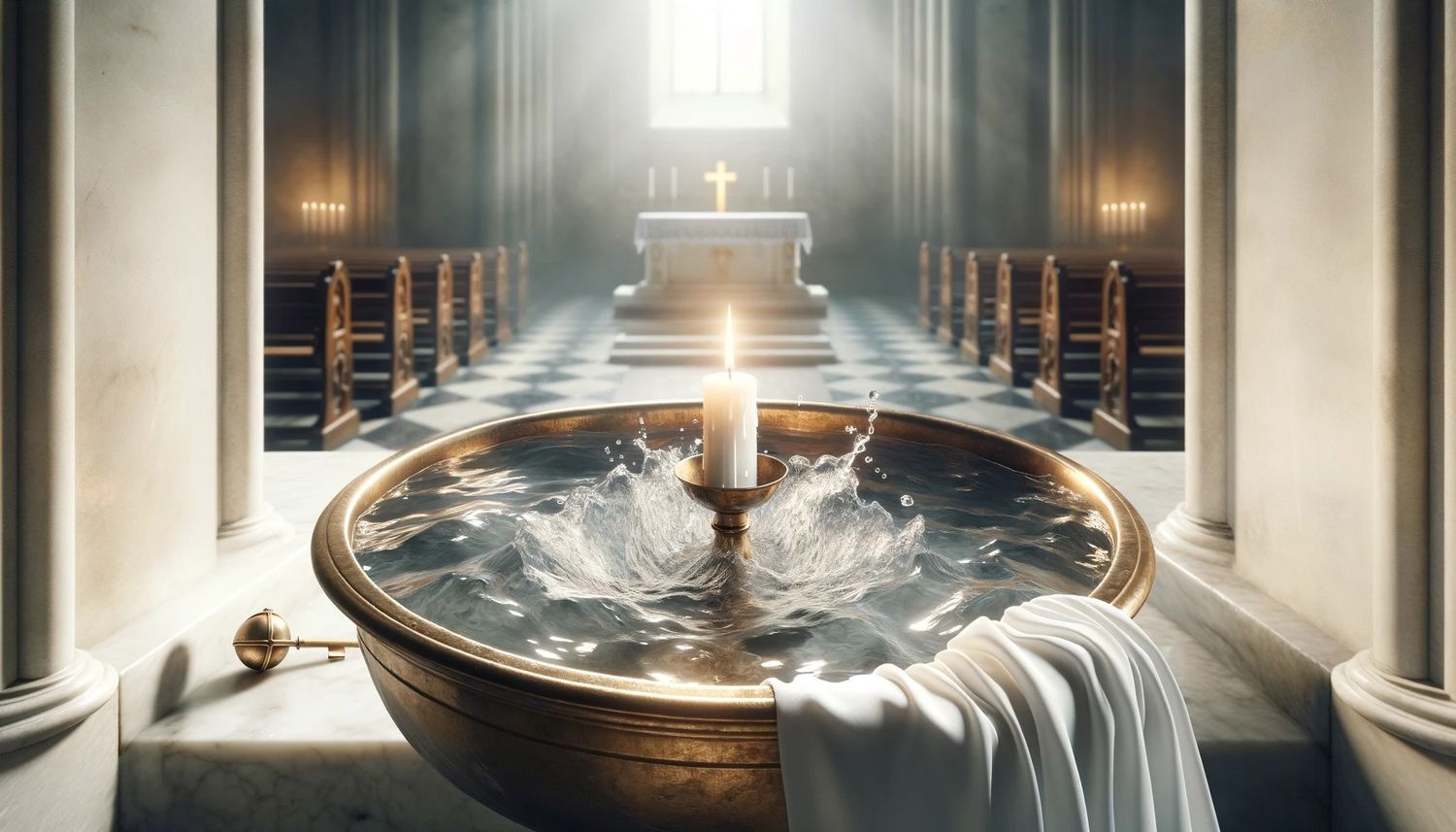Home>Theology and Spirituality>What Does The Catholic Church Teach About Baptism


Theology and Spirituality
What Does The Catholic Church Teach About Baptism
Published: February 26, 2024
Ericka Andersen, an editor at Christian.net, expertly merges digital strategy with content creation, focusing on faith and societal issues. Her communication skills enhance the platform's engaging narratives, fostering meaningful dialogue on belief's impact on society.
Discover the Catholic Church's teachings on baptism and its significance in theology and spirituality. Learn about the sacrament's role in the faith journey.
(Many of the links in this article redirect to a specific reviewed product. Your purchase of these products through affiliate links helps to generate commission for Christian.net, at no extra cost. Learn more)
Table of Contents
The Importance of Baptism in the Catholic Church
Baptism holds immense significance in the Catholic Church, as it is considered the gateway to the other sacraments. It is the first of the seven sacraments and is seen as the foundation of the Christian life. Here are some key reasons why baptism is of utmost importance in the Catholic Church:
-
Initiation into the Church: Through baptism, individuals become members of the Church, the body of Christ. This sacrament marks the beginning of a person's journey as a Catholic and their incorporation into the community of believers.
-
Cleansing from Original Sin: According to Catholic teaching, baptism cleanses individuals from the stain of original sin, which is believed to be inherited from the sin of Adam and Eve. This purification opens the way to a new life in Christ.
-
Reception of Grace: Baptism is believed to bestow grace upon the individual, empowering them to live a life in accordance with the teachings of Jesus Christ. This grace is seen as essential for leading a life of faith and virtue.
-
Seal of Eternal Life: The Catholic Church teaches that through baptism, individuals receive the promise of eternal life. It is through this sacrament that one becomes a part of God's family and gains the hope of salvation.
-
Preparation for Other Sacraments: Baptism paves the way for the reception of other sacraments such as Confirmation, Eucharist, and Matrimony. It is the foundational sacrament that enables individuals to participate fully in the life of the Church.
-
Symbol of New Birth: Baptism is viewed as a symbol of spiritual rebirth. Just as a child is born into the world, baptism represents a spiritual birth into the life of grace.
In summary, baptism is of paramount importance in the Catholic Church as it marks the beginning of a person's journey of faith, cleanses them from original sin, bestows grace, offers the promise of eternal life, and prepares them for active participation in the sacramental life of the Church.
The Sacramental Nature of Baptism
Baptism is deeply rooted in the sacramental nature of the Catholic Church. It is considered a sacrament, a visible sign of God's grace and presence in the world. The sacramental nature of baptism is characterized by several key elements:
-
Visible Sign of Grace: Baptism is a tangible and visible sign of the grace that God bestows upon the individual. Through the pouring of water and the invocation of the Holy Trinity, the sacrament of baptism becomes a physical representation of the spiritual cleansing and rebirth that takes place within the person.
-
Institution by Christ: The sacrament of baptism is not merely a human ritual or tradition; rather, it is an institution established by Jesus Christ himself. In the Gospel of Matthew, Jesus commands his disciples to "Go therefore and make disciples of all nations, baptizing them in the name of the Father and of the Son and of the Holy Spirit" (Matthew 28:19). This divine institution underscores the sacramental nature of baptism as an essential aspect of Christian faith.
-
Entrance into the Church: Baptism is the sacramental rite through which individuals are initiated into the Church. It marks the beginning of their life as members of the Christian community and signifies their participation in the mission and ministry of the Church.
-
Seal of the Holy Spirit: According to Catholic teaching, baptism imparts an indelible spiritual mark on the soul of the individual, known as the "seal of the Holy Spirit." This seal signifies that the baptized person belongs to Christ and is empowered by the Holy Spirit to live as a follower of Jesus.
-
Connection to Other Sacraments: Baptism establishes a foundational connection to the other sacraments of the Church. It is the gateway to the reception of other sacraments, such as Confirmation and the Eucharist, and is thus integral to the sacramental life of the Catholic faithful.
-
Universal Sign of Salvation: The sacramental nature of baptism extends beyond the individual and serves as a universal sign of salvation. It is through baptism that the Church proclaims the saving work of Christ and invites all people to share in the promise of eternal life.
In essence, the sacramental nature of baptism underscores its profound significance as a visible sign of God's grace, an institution established by Christ, an entry into the Church, a seal of the Holy Spirit, a connection to other sacraments, and a universal sign of salvation.
The Role of Baptism in Salvation
Baptism plays a pivotal role in the Catholic Church's understanding of salvation. According to Catholic teaching, baptism is intricately linked to the process of salvation and is viewed as essential for the attainment of eternal life. Here are the key aspects of the role of baptism in salvation:
-
Cleansing from Sin: Baptism is believed to cleanse individuals from the stain of original sin, which is inherited from the fall of Adam and Eve. Through the waters of baptism, this original sin is washed away, and the individual is spiritually reborn, becoming a new creation in Christ.
-
Regeneration and Renewal: The Catholic Church teaches that through baptism, individuals are regenerated and renewed by the Holy Spirit. This spiritual rebirth marks the beginning of a life lived in communion with God and in accordance with the teachings of Jesus Christ.
-
Incorporation into Christ: Baptism is seen as the sacramental rite through which individuals are incorporated into the mystical body of Christ. By being baptized, individuals become united with Christ and share in His redemptive work, thus participating in the salvation He offers.
-
Necessary for Salvation: The Catholic Church holds that baptism is necessary for salvation. While God is not bound by the sacraments and can work outside of them, the ordinary means by which one receives the grace of salvation is through the sacrament of baptism. This understanding underscores the vital role of baptism in the process of salvation.
-
Reception of Sanctifying Grace: Through baptism, individuals receive sanctifying grace, which is the grace that heals and sanctifies the soul. This grace enables the baptized person to grow in holiness and to live a life oriented towards God.
-
Entrance into the Covenant: Baptism is viewed as the sacramental entry into the new covenant established by Jesus Christ. By being baptized, individuals become part of the covenant community and are called to live as faithful disciples of Christ.
In summary, the role of baptism in salvation is multifaceted, encompassing cleansing from sin, regeneration and renewal, incorporation into Christ, necessity for salvation, reception of sanctifying grace, and entrance into the new covenant. According to Catholic teaching, baptism is not merely a symbolic act, but a sacrament through which God imparts His saving grace and initiates individuals into the divine life of the Church.
The Rite of Baptism in the Catholic Church
The rite of baptism in the Catholic Church is a sacred and symbolic ritual that follows a prescribed form and sequence. It encompasses various elements that hold deep spiritual significance and reflect the Church's rich tradition and theology. The rite of baptism unfolds in a structured manner, incorporating specific prayers, gestures, and symbols that convey profound spiritual truths. Here is a detailed exploration of the rite of baptism in the Catholic Church:
-
Welcome and Opening Prayer: The rite commences with a warm welcome extended to the child or adult being baptized, as well as to the assembled community of faith. The celebrant then offers an opening prayer, invoking God's presence and blessings upon the baptismal ceremony.
-
Renunciation of Sin and Profession of Faith: The baptismal candidate, or their parents and godparents in the case of infant baptism, are called upon to renounce sin and profess their faith in God. This renunciation and profession of faith signify a turning away from darkness and a wholehearted embrace of the Christian faith.
-
Blessing of the Water: The celebrant blesses the baptismal water, calling upon the Holy Spirit to sanctify the water and make it a source of spiritual rebirth. This blessing underscores the sacramental nature of water as a symbol of cleansing and new life.
-
Pouring of Water and Trinitarian Formula: The pivotal moment of the rite occurs as the candidate is baptized with water. The celebrant pours water over the candidate's head or immerses them in water, while invoking the Trinitarian formula ("I baptize you in the name of the Father, and of the Son, and of the Holy Spirit"). This action symbolizes the cleansing of sin and the individual's incorporation into the life of the Triune God.
-
Anointing with Chrism: Following the baptism, the newly baptized person is anointed with sacred chrism, a perfumed oil consecrated by the bishop. This anointing signifies the bestowal of the Holy Spirit and the individual's participation in the prophetic, priestly, and kingly mission of Christ.
-
Reception of the White Garment: The newly baptized person is clothed with a white garment, symbolizing their new life in Christ and their call to walk in the light of faith. This act signifies the putting on of Christ and the purity of heart that comes with the grace of baptism.
-
Presentation of the Baptismal Candle: A baptismal candle, lit from the Paschal candle, is presented to the newly baptized or their parents and godparents. This candle symbolizes the light of Christ and the call to live as children of the light, dispelling the darkness of sin and evil.
-
Prayer of the Faithful and Blessing: The rite concludes with the community offering prayers for the newly baptized and their family, as well as a blessing imparted by the celebrant. This prayerful support and blessing affirm the baptized person's entry into the ecclesial community and their ongoing journey of faith.
In essence, the rite of baptism in the Catholic Church is a profound and multifaceted ceremony that encompasses welcome, renunciation, blessing, anointing, clothing, and prayer. It is a visible sign of God's saving action and the individual's incorporation into the life of the Church.
The Effects of Baptism according to Catholic Teaching
-
Cleansing from Sin: Baptism, according to Catholic teaching, cleanses the individual from original sin and any personal sins committed prior to baptism. This cleansing is symbolized by the pouring of water and signifies a spiritual purification, washing away the taint of sin and initiating a new life in Christ.
-
Incorporation into Christ: Through baptism, the individual is incorporated into the mystical body of Christ, becoming a member of the Church. This incorporation signifies a profound union with Christ and participation in His redemptive work, as well as a commitment to living in communion with other members of the Christian community.
-
Participation in the Priesthood of Christ: Catholic teaching holds that through baptism, the baptized person shares in the common priesthood of all believers. This participation empowers them to offer spiritual sacrifices and to intercede for others, reflecting the priestly role of Christ and the call to serve God and neighbor.
-
Reception of the Holy Spirit: Baptism is believed to impart the gift of the Holy Spirit to the individual, marking them as a temple of the Holy Spirit. This reception of the Spirit enables the baptized person to live as a witness to the Gospel and to bear the fruits of the Spirit in their daily life.
-
Adoption as Children of God: According to Catholic teaching, baptism confers upon the individual the status of being a beloved child of God. This adoption into God's family establishes a filial relationship with the Father and grants the baptized person the right to inherit the promises of God's kingdom.
-
Empowerment for Christian Living: Baptism bestows upon the individual the grace needed to live a life of faith and virtue. This grace enables the baptized person to resist sin, to grow in holiness, and to live in accordance with the teachings of Jesus Christ, thus empowering them to fulfill their vocation as a disciple of Christ.
In summary, according to Catholic teaching, the effects of baptism encompass cleansing from sin, incorporation into Christ and the Church, participation in the priesthood of Christ, reception of the Holy Spirit, adoption as children of God, and empowerment for Christian living. These effects highlight the transformative nature of baptism and its significance in the life of the baptized individual within the Catholic faith.















